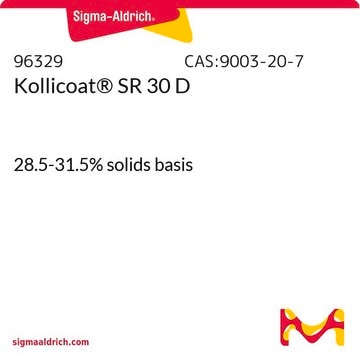02286
Kollidon® 25
Synonym(e):
Polyvinylpyrrolidon, PVP, Polyvidon, Povidon
About This Item
Empfohlene Produkte
Verunreinigungen
≤1 ppm hydrazine
≤10 ppm heavy metals (verified on random samples only)
≤10 ppm lead (verified on random samples only)
≤10 ppm vinylpyrrolidinone
≤3.0% 2-pyrrolidone
≤400 ppm peroxides (as H2O2)
≤5.0% water
≤500 ppm aldehydes (as acetaldehyde)
≤5000 ppm formic acid
12.0-12.8% nitrogen (anhydrous basis)
Glührückstand
≤0.1% (verified on random samples only)
pH-Wert
3.0-5.0
Eignung
complies for Infrared spectrum
Anwendung(en)
sample preservation
SMILES String
C=CN1CCCC1=O
InChI
1S/C6H9NO/c1-2-7-5-3-4-6(7)8/h2H,1,3-5H2
InChIKey
WHNWPMSKXPGLAX-UHFFFAOYSA-N
Suchen Sie nach ähnlichen Produkten? Aufrufen Leitfaden zum Produktvergleich
Verwandte Kategorien
Anwendung
Kollidon SR ist eine Mischung aus Polyvinylacetat und Povidon (K 30) in einem Verhältnis von 8:2 zur Verwendung als matrixbildendes Mittel. Dieses Produkt in Forschungsqualität ist nur zur Verwendung in der Forschung und Entwicklung vorgesehen.
Sonstige Hinweise
Rechtliche Hinweise
Lagerklassenschlüssel
11 - Combustible Solids
WGK
WGK 1
Flammpunkt (°F)
Not applicable
Flammpunkt (°C)
Not applicable
Analysenzertifikate (COA)
Suchen Sie nach Analysenzertifikate (COA), indem Sie die Lot-/Chargennummer des Produkts eingeben. Lot- und Chargennummern sind auf dem Produktetikett hinter den Wörtern ‘Lot’ oder ‘Batch’ (Lot oder Charge) zu finden.
Besitzen Sie dieses Produkt bereits?
In der Dokumentenbibliothek finden Sie die Dokumentation zu den Produkten, die Sie kürzlich erworben haben.
Kunden haben sich ebenfalls angesehen
Unser Team von Wissenschaftlern verfügt über Erfahrung in allen Forschungsbereichen einschließlich Life Science, Materialwissenschaften, chemischer Synthese, Chromatographie, Analytik und vielen mehr..
Setzen Sie sich mit dem technischen Dienst in Verbindung.


